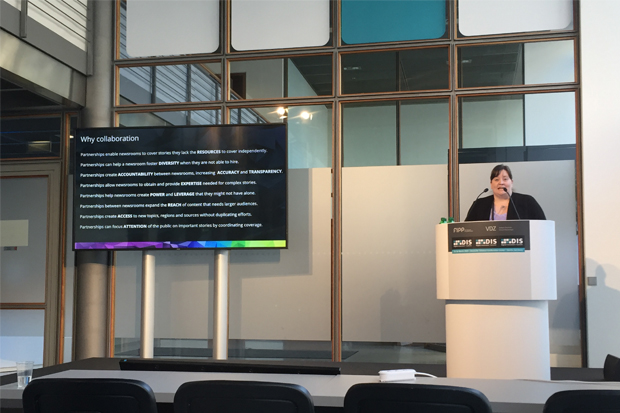
Two heads are better than one, but that does not always come naturally to journalists, said Heather Bryant, founder and director, Project Facet, speaking at Digital Innovators’ Summit (25 March).
"We have a long history of exclusives and the vast majority of newsrooms were built to compete with each other. We’re not designed for collaboration," she said during her talk.
But with recent acclaim of collaborative journalism projects, there is a whole raft of benefits to putting competitiveness aside.
"Collaborations are a tiny percentage of what we do but are still rising to the very best of what we produce. What makes it worth all of the work?" she asked.
"It’s not going to fix everything overnight but it can address a lot of problems we have. Collaboration is how we can create the resources we need, to foster diversity in our organisations, to increase accountability, accuracy and transparency.
"It’s about creating the many levels of expertise you need for a story or providing it to someone else. It helps create the power and leverage needed to get responses from government entities and powerful groups who would otherwise ignore information requests. It’s about reach and access."
The benefits are not one-sided, noted Bryant. The prominent examples of First Draft and its 2017 Crosscheck project show how collaborations can improve not just journalists’ work but also their relationship with readers and audiences.
The project saw around 40 regional newsrooms work together for the first time to verify information bubbling around the French 2017 election — and it has recently been expanded into reporting on the Nigerian 2019 election.
Studies have shown that journalists who took part felt more accountable and did not have to issue a single correction. Add to that, audiences trusted collaborative reports more because it appeared to them more independent.

Collaboration can be a tricky process though and this is where Project Facet comes in. It provides an open-source infrastructure for collaborative projects in one space, as opposed to the multiple platforms often used for communication, editing, distribution and task delegation, which Bryant said can quickly get out of hand.
To make your next collaboration work, she came up with a three-stage process: consider, manage and assess.
Consider
The starting point usually revolves around internal questions: Is this the right fit? How will this help my goals?
Newsrooms should flip the question and evaluate what they are bringing to the table instead. This can range from quality and expertise to reputation and experience, but also ensuring the entire team is invested in the vision.
"This will help you navigate decisions and reduce friction. You will never find a newsroom that is exactly matched to your resources, you have to have an idea of what the capacities are of all the partners and come to mutually agreed upon expectations and deliverables, and value each partner for their unique contributions," Bryant said.
"Know what your leadership structure looks like. The most successful collaborations tend to have a person who is running the show and a clear process for how people work through the structure."
Manage
Step two is managing a shared workflow with clear methods and document progress.
"Collaborations live and die by the inclusiveness of their communication. You have to make sure everybody is fully informed and make sure people can participate fully in the conversations," she explained.
Assess
Then the final phase is assessing the project afterwards and extracting key learned lessons.
"We are fantastic at assessing everything else in the world as journalists. We have to be better at assessing ourselves and the work that we do. It’s important when you reach a key moment in the collaboration that you can check in and touch base about what worked, what could be better, and who you would work with again."
"We are at an important moment to collaborate because we have to. The world is not getting simpler, the stories will not suddenly become less complicated, the challenges we’re facing as an industry aren’t going away.
"Add to that, you don’t have to look far for a politician, business leader or special interest that is happy for us to be weaker and with fewer resources when we choose to isolate ourselves.
"I want you to think the next story you don’t want to miss and remember: by working together, you can ensure that you don’t."
Free daily newsletter
If you like our news and feature articles, you can sign up to receive our free daily (Mon-Fri) email newsletter (mobile friendly).
Related articles
- Blockchain can help news publishers fight risks posed by fake news websites
- Five media sustainability lessons from The Economist
- RISJ Digital News Report 2024: User needs with Vogue and The Conversation
- Video meets podcast: Five tips for making a successful 'vodcast'
- Social media-inspired content strategies for your newsroom









